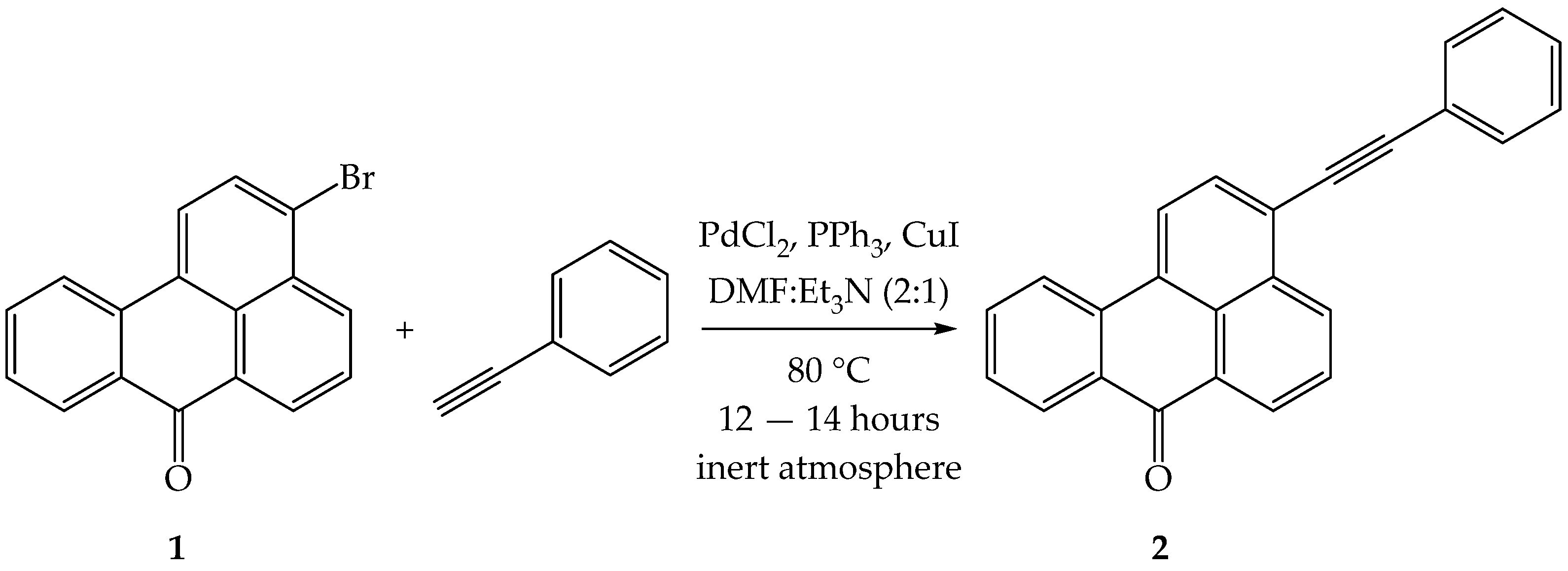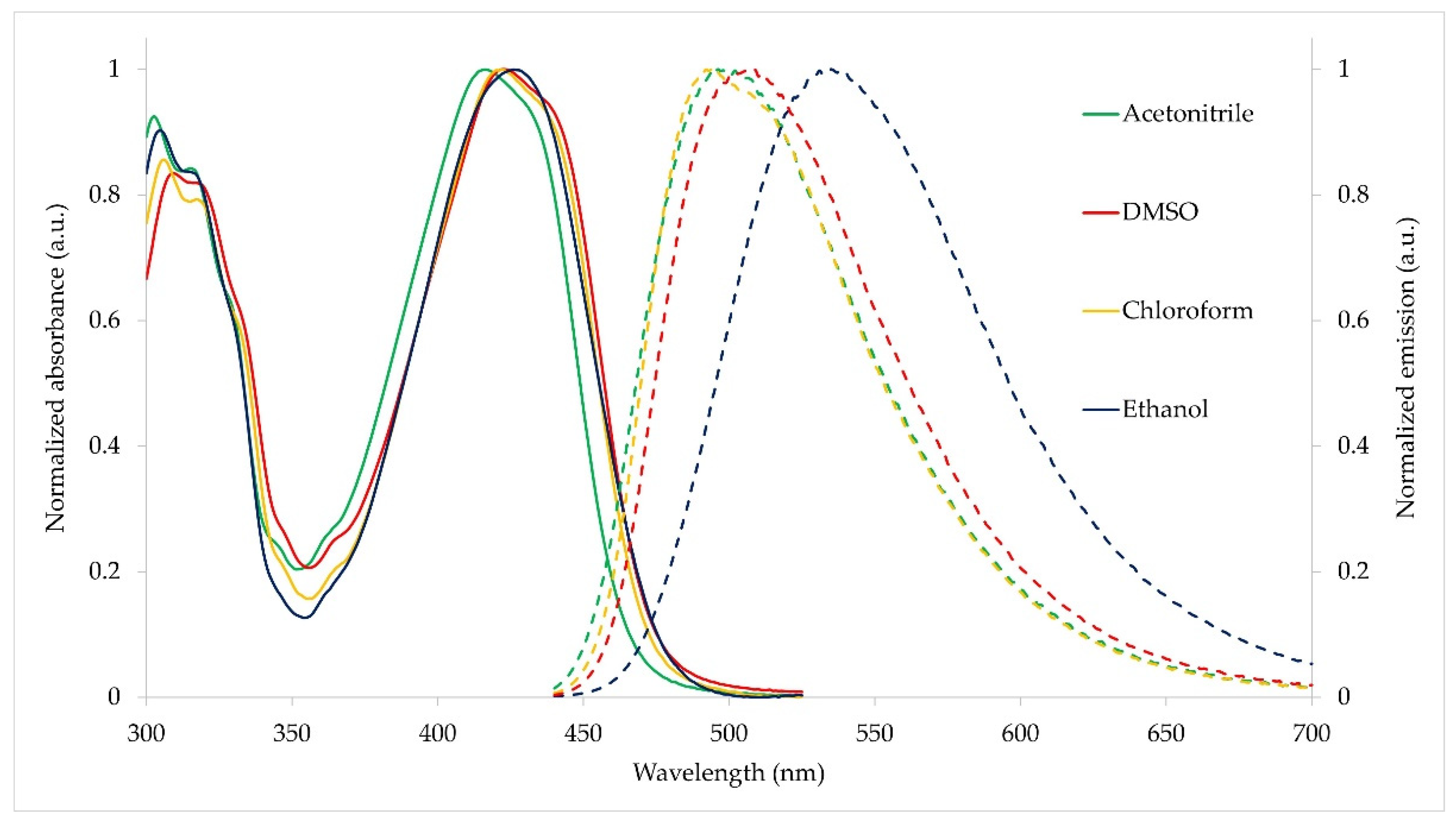3-(Phenylethynyl)-7H-benzo[de]anthracen-7-one
Abstract
:1. Introduction
2. Results and Discussion
2.1. Synthesis
2.2. Photophysical Properties
3. Materials and Methods
3.1. Materials and Basic Measurements
3.2. Synthesis and Characterization
4. Conclusions
Supplementary Materials
Author Contributions
Funding
Institutional Review Board Statement
Informed Consent Statement
Data Availability Statement
Acknowledgments
Conflicts of Interest
Sample Availability
References
- Shivraj, S.; Siddlingeshwar, B.; Kirilova, E.M.; Belyakov, S.V.; Divakar, D.D.; Alkheraif, A.A. Photophysical Properties of Benzanthrone Derivatives: Effect of Substituent, Solvent Polarity and Hydrogen Bonding. Photochem. Photobiol. Sci. 2018, 17, 453–464. [Google Scholar] [CrossRef] [PubMed]
- Romanovska, E.; Pučkins, A.; Grigorjeva, T.; Kirilova, E. N′-(3-Bromo-7-Oxo-7H-Benzo[de]Anthracen-9-Yl)-N,N-Dimethylimidoformamide. Molbank 2022, 2022, M1323. [Google Scholar] [CrossRef]
- Kirilova, A.; Pučkins, A.; Belyakov, S.; Kirilova, E. 3-[N-(4-Methoxybenzyl)Amino]Benzo[de]Anthracen-7-One. Molbank 2021, 2021, M1287. [Google Scholar] [CrossRef]
- Rubenina, I.; Gavarane, I.; Kirilova, E.; Mezaraupe, L.; Kirjusina, M. Comparison of the Benzanthrone Luminophores: They Are Not Equal for Rapid Examination of Parafasciolopsis Fasciolaemorpha (Trematoda: Digenea). Biomolecules 2021, 11, 598. [Google Scholar] [CrossRef] [PubMed]
- Kirilova, E.M.; Kecko, S.; Mežaraupe, L.; Gavarāne, I.; Pučkins, A.; Mickeviča, I.; Rubeniņa, I.; Osipovs, S.; Bulanovs, A.; Pupiņš, M.; et al. Novel Luminescent Dyes for Confocal Laser Scanning Microscopy Used in Parasite Trematoda Diagnostics. Acta Biochim. Pol. 2018, 65, 449–454. [Google Scholar] [CrossRef] [PubMed]
- Kirilova, E.; Mickevica, I.; Mezaraupe, L.; Puckins, A.; Rubenina, I.; Osipovs, S.; Kokina, I.; Bulanovs, A.; Kirjusina, M.; Gavarane, I. Novel Dye for Detection of Callus Embryo by Confocal Laser Scanning Fluorescence Microscopy. Luminescence 2019, 34, 353–359. [Google Scholar] [CrossRef]
- Gavarane, I.; Kirilova, E.; Rubeniņa, I.; Mežaraupe, L.; Osipovs, S.; Deksne, G.; Pučkins, A.; Kokina, I.; Bulanovs, A.; Kirjušina, M. A Simple and Rapid Staining Technique for Sex Determination of Trichinella Larvae Parasites by Confocal Laser Scanning Microscopy. Microsc. Microanal. 2019, 25, 1491–1497. [Google Scholar] [CrossRef]
- Vus, K.; Trusova, V.; Gorbenko, G.; Kirilova, E.; Kirilov, G.; Kalnina, I.; Kinnunen, P. Novel Aminobenzanthrone Dyes for Amyloid Fibril Detection. Chem. Phys. Lett. 2012, 532, 110–115. [Google Scholar] [CrossRef]
- Vus, K.; Trusova, V.; Gorbenko, G.; Sood, R.; Kirilova, E.; Kirilov, G.; Kalnina, I.; Kinnunen, P. Fluorescence Investigation of Interactions Between Novel Benzanthrone Dyes and Lysozyme Amyloid Fibrils. J. Fluoresc. 2014, 24, 493–504. [Google Scholar] [CrossRef]
- Grabchev, I.; Moneva, I. Synthesis and Properties of Benzanthrone Derivatives as Luminophore Dyes for Liquid Crystals. Dye. Pigment. 1998, 37, 155–164. [Google Scholar] [CrossRef]
- Grabchev, I.; Moneva, I.; Wolarz, E.; Bauman, D. Fluorescent 3-Oxy Benzanthrone Dyes in Liquid Crystalline Media. Dye. Pigment. 2003, 58, 1–6. [Google Scholar] [CrossRef]
- Konstantinova, T.N. The Synthesis of Some Benzanthrone Derivatives for Use as Dyes for Polymeric Materials. Dye. Pigment. 1989, 10, 63–67. [Google Scholar] [CrossRef]
- Maļeckis, A.; Avotiņa, L.; Ķizāne, G.; Pučkins, A.; Osipovs, S.; Kirilova, E. New Fluorescent Heterocyclic Compounds Derived From 3-Cyanobenzanthrone. Polycycl. Aromat. Compd. 2021, 1–13. [Google Scholar] [CrossRef]
- Bulanovs, A.; Kirilov, G.; Fleisher, M.; Kirilova, E.; Mihailova, I. Luminescence and Structural Properties of Thermally Evaporated Benzanthrone Dyes Thin Films. Opto-Electron. Rev. 2013, 21, 227–232. [Google Scholar] [CrossRef]
- Kirilova, E.; Bulanovs, A.; Puckins, A.; Romanovska, E.; Kirilov, G. Spectral and Structural Characterization of Chromium(III) Complexes Bearing 7-Oxo-7H-Benzo[de]Anthracen-3-Yl-Amidines Ligand. Polyhedron 2019, 157, 107–115. [Google Scholar] [CrossRef]
- Barman, D.; Narang, K.; Parui, R.; Zehra, N.; Khatun, M.N.; Adil, L.R.; Iyer, P.K. Review on Recent Trends and Prospects in Π-conjugated Luminescent Aggregates for Biomedical Applications. Aggregate 2022, e172. [Google Scholar] [CrossRef]
- Maeda, H.; Maeda, T.; Mizuno, K.; Fujimoto, K.; Shimizu, H.; Inouye, M. Alkynylpyrenes as Improved Pyrene-Based Biomolecular Probes with the Advantages of High Fluorescence Quantum Yields and Long Absorption/Emission Wavelengths. Chem.-A Eur. J. 2006, 12, 824–831. [Google Scholar] [CrossRef]
- Astakhova, I.V.; Korshun, V.A.; Wengel, J. Highly Fluorescent Conjugated Pyrenes in Nucleic Acid Probes: (Phenylethynyl)Pyrenecarbonyl-Functionalized Locked Nucleic Acids. Chem.-A Eur. J. 2008, 14, 11010–11026. [Google Scholar] [CrossRef]
- Prokhorenko, I.A.; Astakhova, I.V.; Momynaliev, K.T.; Zatsepin, T.S.; Korshun, V.A. Phenylethynylpyrene Excimer Forming Hybridization Probes for Fluorescence SNP Detection. In Single Nucleotide Polymorphisms; Humana Press: Totowa, NJ, USA, 2009; pp. 209–222. [Google Scholar]
- Chen, M.; Wei, J.; Zhang, Y.; Wu, L.; Tan, L.; Shi, S.; Shi, J.; Ji, L. 2,7-Carbazole Derived Organoboron Compounds: Synthesis and Molecular Fluorescence. Front. Chem. 2021, 9, 754298. [Google Scholar] [CrossRef]
- Yang, J.; Dass, A.; Rawashdeh, A.-M.M.; Sotiriou-Leventis, C.; Panzner, M.J.; Tyson, D.S.; Kinder, J.D.; Leventis, N. Arylethynyl Substituted 9,10-Anthraquinones: Tunable Stokes Shifts by Substitution and Solvent Polarity. Chem. Mater. 2004, 16, 3457–3468. [Google Scholar] [CrossRef]
- Yang, J.-X.; Wang, X.-L.; Wang, X.-M.; Xu, L.-H. The Synthesis and Spectral Properties of Novel 4-Phenylacetylene-1,8-Naphthalimide Derivatives. Dye. Pigment. 2005, 66, 83–87. [Google Scholar] [CrossRef]
- Bai, J.-Y.; Xie, Y.-Z.; Wang, C.-J.; Fang, S.-Q.; Cao, L.-N.; Wang, L.-L.; Jin, J.-Y. A Quninolylthiazole Derivatives as an ICT-Based Fluorescent Probe of Hg(II) and Its Application in Ratiometric Imaging in Live HeLa Cells. J. Fluoresc. 2018, 28, 795–800. [Google Scholar] [CrossRef] [PubMed]
- Yamaguchi, Y.; Matsubara, Y.; Ochi, T.; Wakamiya, T.; Yoshida, Z. How the π Conjugation Length Affects the Fluorescence Emission Efficiency. J. Am. Chem. Soc. 2008, 130, 13867–13869. [Google Scholar] [CrossRef] [PubMed]
- Piskunov, A.V.; Moroz, A.A.; Shvartsberg, M.S. Nucleophilic Addition of Secondary Amines to Acetylenylanthraquinones. Bull. Acad. Sci. USSR Div. Chem. Sci. 1986, 35, 785–790. [Google Scholar] [CrossRef]
- Nebra, N.; García-Álvarez, J. Recent Progress of Cu-Catalyzed Azide-Alkyne Cycloaddition Reactions (CuAAC) in Sustainable Solvents: Glycerol, Deep Eutectic Solvents, and Aqueous Media. Molecules 2020, 25, 2015. [Google Scholar] [CrossRef] [PubMed]
- Wang, T.; Zhang, N.; Bai, W.; Bao, Y. Fluorescent Chemosensors Based on Conjugated Polymers with N-Heterocyclic Moieties: Two Decades of Progress. Polym. Chem. 2020, 11, 3095–3114. [Google Scholar] [CrossRef]
- Tsiko, U.; Sych, G.; Volyniuk, D.; Bezvikonnyi, O.; Keruckiene, R.; Lazauskas, A.; Grazulevicius, J.V. Self-Recovering Mechanochromic Luminescence of the Derivatives of Benzanthrone and Carbazole: Towards Damage-Resistive Information Recording and Security Probes. Dye. Pigment. 2022, 199, 110082. [Google Scholar] [CrossRef]
- Sonogashira, K.; Tohda, Y.; Hagihara, N. A Convenient Synthesis of Acetylenes: Catalytic Substitutions of Acetylenic Hydrogen with Bromoalkenes, Iodoarenes and Bromopyridines. Tetrahedron Lett. 1975, 16, 4467–4470. [Google Scholar] [CrossRef]
- Rao, A.V.R.; Vaidyanathan, A. The 1H NMR Spectrum of Benzanthrone. Spectrochim. Acta A 1981, 37, 145–146. [Google Scholar] [CrossRef]
- Vaidyanathan, A. The Carbon-13 NMR Spectra of Benzanthrone and Its Derivatives. Dye. Pigment. 1982, 3, 243–248. [Google Scholar] [CrossRef]
- Takekawa, M.; Aoki, J.; Iwashima, S.; Ueda, T. Complete Assignment Of1H And13C NMR Spectra of Chlorobenzanthrones. Magn. Reson. Chem. 1994, 32, 87–92. [Google Scholar] [CrossRef]


| Solvent | Dielectric Constant | Absorption λabs, nm | Fluorescence λem, nm | Quantum Yield |
|---|---|---|---|---|
| Chloroform | 4.89 | 422 | 492 | 0.38 |
| Ethanol | 24.55 | 426 | 535 | 0.68 |
| Acetonitrile | 35.94 | 416 | 496 | 0.22 |
| Dimethyl sulfoxide | 46.45 | 423 | 507 | 0.32 |
Publisher’s Note: MDPI stays neutral with regard to jurisdictional claims in published maps and institutional affiliations. |
© 2022 by the authors. Licensee MDPI, Basel, Switzerland. This article is an open access article distributed under the terms and conditions of the Creative Commons Attribution (CC BY) license (https://creativecommons.org/licenses/by/4.0/).
Share and Cite
Maļeckis, A.; Griškjāns, E.; Cvetinska, M.; Kirilova, E. 3-(Phenylethynyl)-7H-benzo[de]anthracen-7-one. Molbank 2022, 2022, M1442. https://doi.org/10.3390/M1442
Maļeckis A, Griškjāns E, Cvetinska M, Kirilova E. 3-(Phenylethynyl)-7H-benzo[de]anthracen-7-one. Molbank. 2022; 2022(3):M1442. https://doi.org/10.3390/M1442
Chicago/Turabian StyleMaļeckis, Armands, Evans Griškjāns, Marija Cvetinska, and Elena Kirilova. 2022. "3-(Phenylethynyl)-7H-benzo[de]anthracen-7-one" Molbank 2022, no. 3: M1442. https://doi.org/10.3390/M1442
APA StyleMaļeckis, A., Griškjāns, E., Cvetinska, M., & Kirilova, E. (2022). 3-(Phenylethynyl)-7H-benzo[de]anthracen-7-one. Molbank, 2022(3), M1442. https://doi.org/10.3390/M1442






